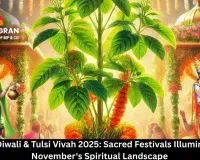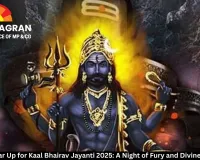Budh Ashtami Vrat 2025: A Sacred Fast for Spiritual Merit and Worldly Success
Digital Desk

Observing the Budh Ashtami Vrat is believed to free devotees from the cycle of sin and ensure prosperity, making it a significant day in the Hindu lunar calendar. Our article covers the date, rituals, and profound significance of this fast.
In Hindu spirituality, the convergence of a specific lunar day and a weekday often creates a potent opportunity for worship. Budh Ashtami, the auspicious occasion when the Ashtami (eighth) Tithi coincides with a Wednesday (Budhwar), is one such day.
Dedicated to the planet Mercury (Budh) and often involving the worship of Lord Shiva and Goddess Parvati, this fast is a powerful means for devotees to seek spiritual redemption and material progress .
For devout observers, adhering to the Budh Ashtami Vrat is a profound religious practice. Scriptures like the Brahmanda Purana state that performing the rituals on this day brings holistic peace and frees an individual from sins committed in previous births . It is strongly believed that one who observes this fast with sincerity never has to face the tortures of hell after death, as it destroys all accumulated sins .
Budh Ashtami Vrat Date and Time
This sacred fast is observed on every Ashtami Tithi that falls on a Wednesday, regardless of whether it occurs in the Shukla Paksha (waxing phase of the moon) or Krishna Paksha (waning phase) . In 2025, this vow will be observed on several dates, with one of the key occurrences being:
- Wednesday, 12 November 2025
- Ashtami Tithi Begins: 11 November 2025 at 11:09 PM
- Ashtami Tithi Ends: 12 November 2025 at 10:58 PM
Other Budh Ashtami dates in 2025 include May 1, May 15, and September 11, providing multiple opportunities for observance throughout the year .
Rituals and Worship Method (Puja Vidhi)
The observance of Budh Ashtami involves specific rituals performed with devotion. The following steps outline the common Puja Vidhi:
- Sacred Bath: Devotees wake up during the Brahma Muhurta (before sunrise) and take a purifying bath. Adding a few drops of Ganga Jal to the bathing water is considered equivalent to bathing in the holy Ganges .
- Kalash Sthapana: A Kalash (sacred pot) filled with water and topped with a green coconut is established in the worship area .
- Devotional Offerings: The deity of Lord Budh, often in the form of an idol or an image on a coin, is worshipped with offerings of Ganga water, milk, green items, flowers, and incense . Eight types of dishes are prepared and offered to the deity on bamboo leaves .
- Mantra Chanting: Chanting dedicated mantras like "Om Budhay Namah" is an integral part of the worship to invoke the blessings of Mercury .
- Fasting and Charity: Many devotees observe a strict fast, and some consume eight handfuls of food as a symbolic meal . Donating green clothes, green gram, or other green items is also recommended .
Profound Significance and Benefits
The fast is highly revered for its multitude of benefits, both spiritual and worldly.
- Spiritual Merits: The primary significance lies in the destruction of sins from one's current and past lives, leading to salvation (Moksha) .
- Astrological Remediation: For those with a weak or afflicted Mercury (Budh Dosha) in their horoscope, observing this fast is considered immensely beneficial for mitigating negative effects and bringing peace and happiness .
- Material and Personal Growth: The fast is known to bring wealth, progeny, and opulence . It is also believed to enhance intelligence, communication skills, and business prospects, and can lead to success in education, career, and marriage .
By integrating these sincere rituals and understanding their profound significance, devotees can observe the Budh Ashtami Vrat to invite spiritual clarity and worldly prosperity into their lives.








2.jpg)


